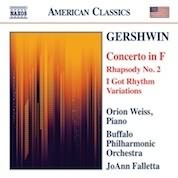It may seem odd to praise a release for what it does not contain, but leaving out Rhapsody in Blue really was a good idea. The piece has been so over-recorded, and evokes such strong opinions from both listeners and critics as to how it ought to go, that it was smart to leave it out rather than risk sinking the whole project by including it just because the playing time permits. Besides, this naturally focuses attention on the Second Rhapsody, a splendid, neglected work that suffers because it doesn’t contain a “big tune”. That’s not quite fair: the work has lots of good tunes–just not a popular one of the slower, more lyrical variety that we find in “Blue”. In any case it is very well played and conducted by the team of Orion Weiss and JoAnn Falletta, and comes across as a work of impressive brilliance and depth. The same goes for the Variations, given a bold, gutsy performance with plenty of pizzazz.
The Concerto, though, is quite different, and not in a bad way. If you look at the score you’ll notice immediately that Gershwin often uses the qualified “poco” (“a little bit”) when he modifies tempo or phrasing. Most performers read this as “molto” (“a lot”), particularly at the initial entrance of the piano. The result sectionalizes the music more than need be, and contributes to the charge that Gershwin was not comfortable working in large forms. This performance is no exception, with Weiss’ initial entrance very much slower than the preceding orchestral introduction, and also with a very moderate tempo taken for much of the finale.
However, as with all such matters, the devil is in the details. First, Weiss’ emphasis on the music’s more reflective elements isn’t a momentary affectation, but a legitimate characteristic of the interpretation as a whole. Second, Falletta seems to be of the same mind: she handles transitions between sections with great care and smoothness, so that the music never loses its flow. Third, both Weiss and Falletta keep rhythms sharp and clear, especially in the outer movements where they matter most, and shade dynamics and accents so that the music retains its color and freshness. Finally, the slow movement, as you might otherwise have expected given the general approach, is not excessively slow, so that the performance never turns dull and the entire work is nicely balanced.
The result, of its type, is one of the more thoughtful and beautiful versions of the work to come out in recent years. As with the performance of the Second Rhapsody, you might hear an unusual degree of “substance” in this interpretation, a seriousness that places the music beyond the usual Pops Concert fare–and heaven knows there’s nothing wrong with that. The disc is also very well recorded and sounds quite impressive in both regular stereo and Blu-ray versions. A very pleasant surprise.
































